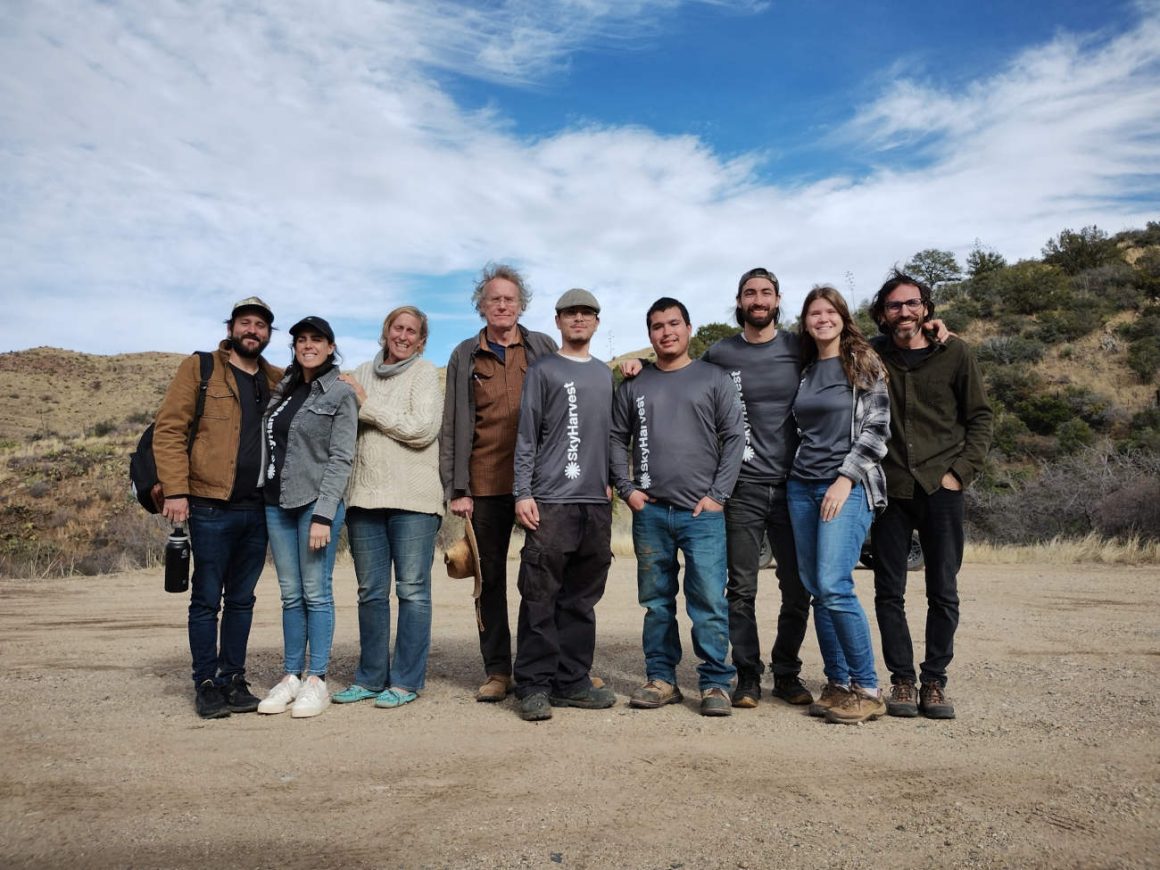A team of volunteers and SkyHarvest staff met on the Bear Springs site in early March to volunteer, evaluate progress and map out the plan for Bear Springs Ecological restoration for 2023.
The team consisted of Project Manager Kat Ehrhorn, Biochar Consultant and Volunteer Coordinator Pachi Coquet, Special Coordinator Bob Cirino, volunteer Hannah Cirino, Grant Writer Eunice De Alba and volunteer Rene Anguiano.
We also had two days of expert training from Borderlands Restoration Network (BRN) Project Developer David Seibert PhD and a field trip to 15 year old loose rock dam project at Josiah Austin’s property which showed the results of this work.
SkyHarvest employees, Manny Tapia and Anthony Javier-Orona, also joined parts of the week for training and observation on loose rock dam construction conducted by Borderlands Restoration Network and Josiah Austin.
Through the support and generosity of private donors and Diamond Mountain Retreat Center, SkyHarvest set off with $133,000 in funding and an ambitious project: plant trees in the desert. A tree without water or soil will not grow, so the SkyHarvest team set out to install 4,500 small basins across the landscape that would slow down the water, build the soil and help seeds germinate.
Check out this professional documentary from volunteer session 2
Over the past 12 months, and two volunteer sessions, we have completed approximately 2,400 basins and sown tens of thousands of seeds in durable clay seed balls. In 2022 the project area received a very significant amount of rain, which tested our basins! Some held strong, but others washed away. It was clear that the basins constructed with stones (instead of only dirt) were the most durable and valuable basins.
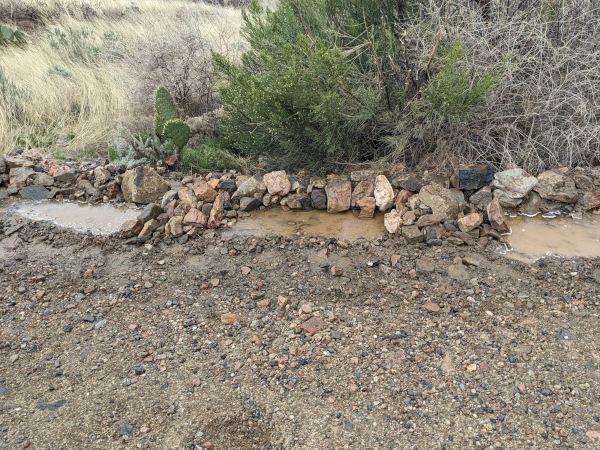
In early 2023, just before Spring officially starts, we see plants germinating in previously barren areas. The sprouts are too small to identify yet!

Though the seeds are still scattered across the landscape, the dirt basins washed out. After seeing this result and consulting with Josiah Austin (who has restored over 60,000 acres of desert grassland) and David Seibert (who has restored gigantic areas along the US-Mexico border through BRN) the path forward became very clear.
To have trees survive without irrigation in the desert, we must increase the total amount of water in the soil. To do that, we must slow down water during big rain events, and accumulate precious topsoil. The results we saw with the tiny rock basins would be amplified many times by locating the rock structures in the washes (the areas that water naturally rushes when it rains heavily) making them much more significant. Water rushing down a steep slope and then slowed by a loose rock dam will force saturation laterally up to 20 feet and more on both sides.
These two photos taken by the team at Bear Springs show before and after a loose rock dam is created to catch water in this small drainage.
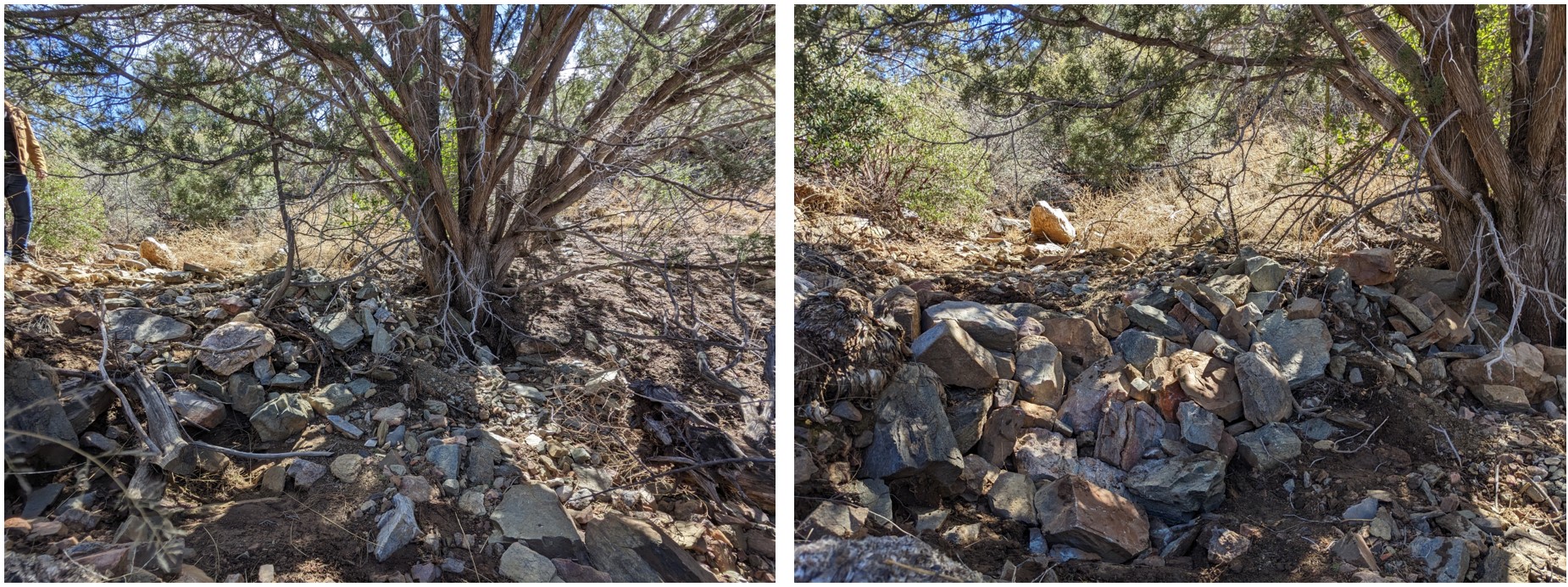
We traveled to one of Josiah’s ranches where this method had been in process for more than 15 years and were astounded by the results.
Please watch this amazing video filmed on Josiah’s land near the Bear Springs site. Can Rock Dams Reverse Climate Change?
With these results and the insight from our restoration mentors, we will leave behind what didn’t work, and amplify what did work, we will more effectively and rapidly prepare the landscape to support tree life.
Review of 2022
The Bear Springs Ecological Restoration five-part plan is designed to remedy the effects of these activities: erosion, soil degradation, species reduction, lowered aquifers and stress on economies.
The plan identifies five objectives. Below in green are status report in those five areas.
1) Design and construct site-specific earthworks-based rainwater catchment and retention methods
Completed
– 1400 basins volunteer session 1
– 1200 basins volunteer session 2
– 3 large swales
Proposed for 2023
– Focus on loose rock dams from highest elevations and down along washes in site 2
– Make ~100 more small stony basins in bare sections of site 2
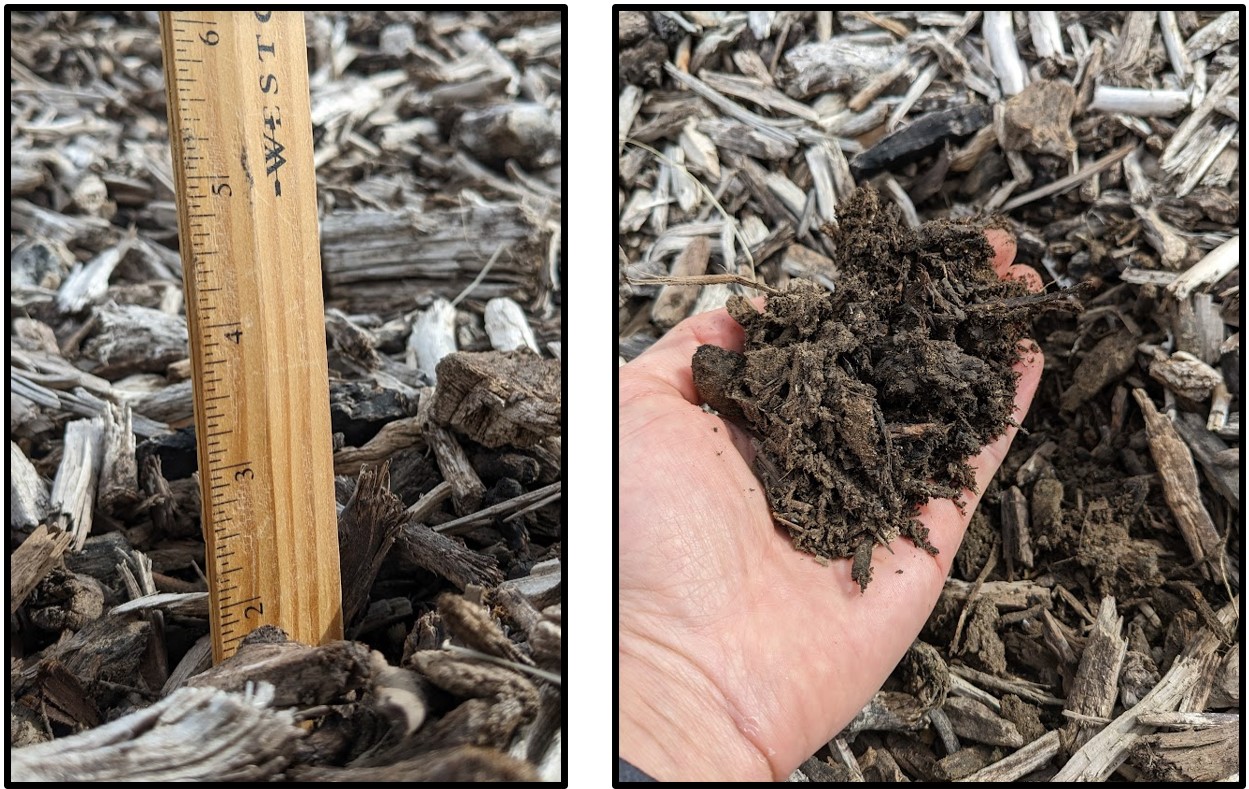
2) Restore and protect soil viability.
– Mulch and biochar were added to the demonstration garden and basins in volunteer session 2.
– Basins are already retaining and revitalizing soil

3) Reseed native vegetation without irrigation.
– Seed stock acquired through the guidance and expertise of Borderlands Restoration Network, chosen for changing climate.
– Planted 8,000 seeds of 4 varieties of trees and many pounds of 30 varieties of wildflowers, grasses, and shrubs. 80% of year one seed is disbursed, 20% remains in inventory. Year two seed will be delivered in June 2023.
– Seed was encased in clay seed balls by volunteers to ensure the best chance of avoiding being eaten by animals and insects before conditions to germinate can occur.
4) Design and plant a demonstration site with mature irrigated vegetation and interpretative signage.
– Irrigation installed
– Large water tank ##gallons and drip line
– Two wildlife ponds with wildlife cameras. Click me to see photos and short videos of the animals at the pond.
– Walking loop with benches and interpretive signage installed so visitors can learn and engage with the restoration
– Planted 30 trees that are native, significant to indigenous culture, and designed to accommodate unknown climate change.
– Native American medicine garden within a traditional Ocotillo fence to demonstrate how ecological restoration can create valuable medicinal products
– Three types of earthworks installed, swales, basins and loose rock dam
This Great Horned Owl is one of many visitors caught on camera at the new watering hole.
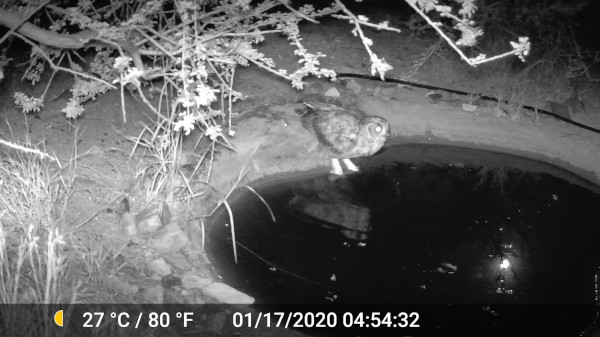
5) Enhance economic viability through sustainability.
– SkyHarvest has hired local people to work on the Bear Springs project
– Borderlands Restoration Network, in collaboration with SkyHarvest and others, secured a grant from National Fish and Wildlife Foundation which will benefit Bear Springs. The grant is for $188,000 divided between three project areas, one of which is Bear Springs. The grant has a matching requirement from BRN, DMRC, and SH. The three organizations will collaborate to bring an additional value of up to $195,000 to the Bear Springs site 3. This investment will result in a minimum of 50 loose rock dams in site 3, removal of invasive species, planting of native plants and seeds and includes education for staff, volunteers and the public. The location of site 3 is a maximum of 75 feet left and right of the wash above the spring at the Ranch house, running from the south property line just south of the hairpin turn up to Blue Sky Dome, with intermittent earthworks implemented to the Retreat Valley Gate.
– Arid land restoration is a politically and socially attractive area of interest to institutions, the scientific community, governments, activists and others compelled to work towards solutions for climate change. SkyHarvest activities at DMRC are attracting positive attention and visitors to the place.
SkyHarvest employees Manny and Anthony are residents of Cochise County, AZ.

What did we learn?
- Basins that are not reinforced with rock wash out in heavy rain and run off. In the future, all basins need to have rock on the downhill side. Jojoba which was planted did not survive the winter and will be replaced with an alternate species that did well.
- The original report called for documentation of each basin and monitoring from a third source to measure success. Once implementation started, the team determined that documenting each basin would not be an effective method of evaluation. The future plan is to work with David Seibert and BRN to document broad-based site changes over a longer time frame, with yearly photos in the same locations throughout the sites. David may be able to connect us with graduate students at the University of Arizona for further study. We propose taking photos of a similar slope and face where we are not working to see the difference that our ecological restoration makes. Rainfall changes from one year to the next, so the health of the plants also changes. Having a control area will be the best way to measure results.
The community of ecological restoration in Cochise County is vibrant. Now that we have made local connections with BRN, Hydrology expert Rudy Poe, and Josiah Austin (grasslands restoration expert/neighbor rancher) we no longer need consultation from Sonoran Permaculture/ Dan Dorsey. The local expertise and methods of measuring success are more applicable. We have also developed a relationship with Jared Allred, a local farmer who will supply us with the mulch needed at Bear Springs. - Volunteer recruit estimates were higher than actuals (estimated 30-50 volunteers per session, and the most recruited were 11). Paying for housing and catered food made volunteer hours in 2022 cost more than hired skilled labor by 2.5 times. DMRC has agreed to house volunteers as of February, 2023 for no charge, and catered food is not provided. Implementation for the 2nd year will primarily be paid local labor at a reduced cost.
SkyHarvest focus for Bear Springs 2023 and beyond
Site 1 – Collaborate with DMRC to maintain the demonstration garden. Add additional mulch and improve water catchment on site 1.
Site 2 – Spend the remainder of initial budget on loose rock dams in the drainages of site 2 using a combination of volunteer and paid labor.
Site 3 – Contribute $85,000 in management hours, volunteer hours, and education from now until September 30th, 2025
In Summary, the board and staff of SkyHarvest see the potential to collaborate for many years with DMRC to implement ecological restoration at Bear Springs wash-by-wash through grants, corporate donations, and individual donations. Protecting the roads and the ground water on the property, while contributing to a healthier environment for all, can be achieved through the simple and effective techniques of earthworks, loose rock dams, biochar, mulch and revegetation.
Financial Report for Bear Springs 2022
The total donations for Bear Springs from DMRC and from individual SkyHarvest donors with restrictions to Bear Springs as of 12.31.2022 is $133,424.
$112,997.86 was spent in 2021 and 2022. The remaining funds will be spent in 2023 on loose rock dams in site 2. Please contact Kat Ehrhorn for the detailed report.
Implementation Schedule
The following proposed schedule was achieved apart from recruiting 30-50 volunteers per volunteer session, conducting a management conference in summer 2022, collecting metrics and volunteer session 3 was replaced with hired local labor.
1st Quarter 2022
1/15 Commence demonstration garden development
1/15 Commence event contract, production & promotion for Volunteer Sessions 1-6
1/15 DMRC irrigation through demonstration garden is installed
1/24 Commence Site 2 plan development
1/24 Wildcrafted seed inventory and seed quotes are prepared
1/30 Approve contract with DMRC by the end of January
1/30 Request and issue 1st Quarter Operating Funds to SH
2/6 On-Site Permaculturist arrives on site to prepare for volunteer session
2/15-2/16 Tractor work for swales on site 1
2/19 – 2/26, Volunteer Session 1, 20-45 volunteers at DMRC
a. Document baseline, commence data collection, and report
b. Begin installation of demonstration garden
c. Construct 1425 earthworks at Sites 1 & 2
d. Wildraft, procure, pelletize and sow seed inventory
e. Sow seed
3/15 SH irrigation is installed
3/22 30 trees planted by partner nursery
3/25 Plant understory shrubbery
2nd Quarter 2022
5/29 – 6/4, Volunteer Session 2, 30-50 people at DMRC
a. Plant seeds for monsoon Sites 1 & 2 total 1425 basins
b. Collect metrics data, analyze, adjust, repair, report
c. Wildcraft, pelletize and sow seed inventory
d. Continue demonstration garden development and installations
3rd Quarter 2022
Project management only
Collect metrics data, analyze, adjust, repair, replant, report
4th Quarter 2022
11/12 – 11/20 Session 3, 30-50 people at DMRC
a. Prepare for winter rains
b. Collect metrics data, analyze, adjust, repair, replant, report
c. Wildcraft, pelletize and sow seed inventory


